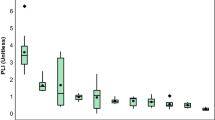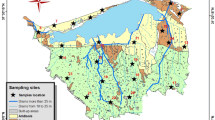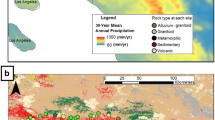Abstract
In Australia, the regulatory framework for assessing the risk of soil contamination assumes there is minimal risk from the natural enrichment of potentially toxic elements in soil. When this assumption is applied to land cleared for anthropogenic purposes, non-adapted biota including humans, domestic animals and garden plants can be exposed to these soils. While the impacts of natural arsenic (As) and fluorine (F) in waterways are widely reported, little is known about the biological impacts of natural As and F in non-aquatic soils. We investigated four field sites with naturally elevated soil As and F around Melbourne, Australia. All sites were assessed for As and F in soil, tree and herb (grasses and forbs) foliage. Soil concentrations of As and F ranged from near to above mean ambient background concentrations for Victoria. Soil As and F under trees were consistently higher than under herbs, suggesting deeper tree roots resulted in translocation and accumulation of As and F from deeper soil layers. While surface soil enrichment by plants is known for nutrients, there is less information about enrichment of potentially toxic elements. No clear relationships between soil and foliar As/F concentrations were found. However, there was a range of As and F accumulations in foliage across the four sites: from low to concentrations representative of contaminated sites and above regulatory guidelines. We demonstrated that soils naturally enriched in As and F can be bioavailable and accumulated in plant foliage. Thus, we suggest reassessment of the assumption in Australian guidance that naturally elevated concentrations of potentially toxic elements are not bioavailable and pose minimal risk.




Similar content being viewed by others
Data Availability
Available upon request.
Code Availability
NA.
Abbreviations
- ABC:
-
Ambient background concentration
- ASC:
-
Assessment of site contamination
- EIL:
-
Ecological investigation level
- ERA:
-
Ecological risk assessment
- HIL:
-
Human health investigation level
- NEPC:
-
National Environment Protection Council
- NEPM:
-
National Environmental Protection (Assessment of Site Contamination) Measure
References
Baker, A. J. (1981). Accumulators and excluders-strategies in the response of plants to heavy metals. Journal of Plant Nutrition, 3, 643–654.
Baker, A. J., & Brooks, R. R. (1989). Terrestrial higher plants which hyperaccumulate metallic elements - a review of their distribution, ecology and phytochemistry. Biorecovery, 1, 81–126.
Baker, A. J., Proctor, J. and Reeves, R. D. (1992). The vegetation of ultramfic (serpentine) soils. First International Conference on Sepentine Ecology, California, USA. Intercept.
Bennett, A. F., & Lenski, R. E. (1993). Evolutionary adaptation to temperature II. Thermal niches of experimental lines of Escherichia coli. International Journal of Organic Evolution, 47, 1–12.
Bhattacharya, P., Welch, A. H., Stollenwek, A. H., McLaughlin, M. J., Bundschuh, J., & Panaullah, G. (2007). Arsenic in the environment: Biology and chemistry. Science of the Total Environment, 379, 109–120.
Boyd, R. S. (2004). Ecology of metal hyperaccumulation. New Phytologist, 162, 563–567.
Boyd, R. S., Davis, M., & Balkwill, K. (2002). Nickel defends the South African hyperaccumulator Senecio coronatus (Asteraceae) against Helix aspersa (Mollusca: Pulmonidae). Chemoecology, 12, 91–97.
Bromfield, S. M., Cumming, R. W., David, D. J., & Williams, C. H. (1983). Change in soil pH, manganese and aluminium under subterranean clover pasture. Australian Journal of Agricultural Animal Husbandry, 23, 181–191.
Brooks, R. R. (1998). Plants that hyperaccumulate heavy metals. CAB International.
Bustingorri, C., & Lavado, R. S. (2014). Soybean as affected by high concentrations of arsenic and fluoride in irrigation water in controlled conditions. Agricultural Water Management, 144, 134–139.
CCME. (2006). Soil quality guidelines for the protection of environmental and human health. In: Canadian Council of Ministers of the Environment. http://st-ts.ccme.ca/en/index.html.
Cesalpino, A. (1583). De Plantis Libri XVI. p. 369.
Cronin, S., Manoharan, V., Hedley, M., & Loganathan, P. (2000). Fluoride: A review of its fate, bioavailability, and risks of fluorosis in grazed-pasture systems in New Zealand. New Zealand Journal of Agricultural Research, 43, 295–321.
Fernando, D. R., Guymer, G., Reeves, R. D., Woodrow, I. E., Baker, A. J., & Batianoff, G. N. (2009). Foliar Mn accumulation in eastern Australian herbarium specimens: Prospecting for ‘new’ Mn hyperaccumulators and its potential application in taxonomy. Annals of Botany, 103, 931–939.
FSANZ. (2017). Australia New Zealand Food Standards Code, Schedule 19, Maximum Levels of Contaminants and Natural Toxicants. Food Standards Australia New Zealand, Canberra, Australia.
Gómez-Ordónez, E., Alonso, E., & Rupérez, P. (2010). A simple ion chromatography method for inorganic anion analysis in edible seaweeds. Talanta, 82, 1313–1317.
Go´mez-Ariza, J. L., Sa´nchez-Rodas, D., Gira´ldez, I., & Morales, E. (2000). A comparison between ICP-MS and AFS detection for arsenic speciation in environmental samples. Talanta, 51, 257–268.
Graham, R. D., Hannam, R. J. and Uren, N. C. (1988). Manganese in soils and plants. In: R. J. Hannam, R. D. Graham, N. C. Uren, (eds) International Symposium on Manganese in Soils and Plants. Kluwer Academic Press.
Jenny, H. (1941). Factors of Soil Formation. McGraw-Hill.
Jobbagy, E. G., & Jackson, R. B. (2004). The uplift of soil nutrients by plants: Biogeochemical consequences across scales. Ecology, 85, 2380–2389.
Kularatne, K. and Pitawala, H. (2012). Leaching of fluoride from biotite mica in soil: Implications for fluoride in shallow groundwater. ISRN Soil Science. International Scholarly Research Network ISRN Soil Science.
Levins, R. (1963). Theory of fitness in a heterogeneous environment. II. Developmental flexibility and niche selection. The American Naturalist, 97, 75–90.
Mandal, B. K., & Suzuki, K. T. (2002). Arsenic round the world: A review. Talanta, 58, 201–235.
Mikkonen, H. G., Clarke, B. O., Dasika, R., Wallis, C. J., & Reichman, S. M. (2017). Assessment of ambient background concentrations of elements in soil using combined survey and open-source data. Science of the Total Environment, 580, 1410–1420.
Mikkonen, H. G., Dasika, R., Drake, J. A., Wallis, C. J., Clarke, B. O., & Reichman, S. M. (2018a). Evaluation of environmental and anthropogenic influences on ambient background metal and metalloid concentrations in soil. Science of the Total Environment, 624, 599–610.
Mikkonen, H. G., van de Graaff, R., Mikkonen, A. T., Clarke, B. O., Dasika, R., Wallis, C. J., et al. (2018b). Environmental and anthropogenic influences on ambient background concentrations of fluoride in soil. Environmental Pollution, 242, 1838-1849.
Naidu, R., Smith, E., Owens, G., & Bhattacharya, P. (2006). Managing arsenic in the environment: From soil to human health. CSIRO publishing.
NEPC. (2013). National Environment Protection (Assessment of Site Contamination) Measure. National Environment Protection Council, Australia.
Rothschild, L. J., & Mancinelli, R. L. (2001). Life in extreme environments. Nature, 409, 1092–1101.
Semple, K. T., Doick, K. J., Jones, K. C., Craven, P. B. A. and Harms, H. (2004). Defining bioavailability and bioaccessibility of contaminated soil and sediment is complicated. Environmental Science and Technology, 38, 229–231.
Soper, F. M., Chamberlain, S. D., Crumsey, J., Gregor, S., Derry, L. A., & Sparks, J. P. (2018). Biological cycling of mineral nutrients in a temperate forested shale catchment. Journal of Geophysical Research: Biogeosciences., 123, 3204–3215.
Stone, E. L., & Kalisz, P. J. (1991). On the maximum extent of tree roots. Forest Ecology and Management, 46, 59–102.
Upadhyay, M. K., Shukla, S., Yadav, P., & Srivastava, S. (2019). A review of arsenic in crops, vegetables, animals and food products. Food Chemistry., 278, 608–618.
Weinstein, L. H. (1977). Fluoride in plant life. Journal of Occupational Medicine, 19, 49–78.
Wilson, R., Jones-Otazo, H., Petrovic, S., Mitchell, I., Bonvalot, Y., Williams, D., & Richardson, G. M. (2013). Revisiting dust and soil ingestion rates based on hand-to-mouth transfer. Human and Ecological Risk Assessment: An International Journal, 19, 158–188.
Yang, Z. B., You, J. F., Xu, M. Y., & Yang, Z. M. (2009). Interaction between aluminium toxicity and manganese toxicity in soybean (Glycine max). Plant and Soil, 319, 277–289.
Acknowledgements
The authors would like to acknowledge the financial support of the Hazwaste Fund (project S43-0065) and the Australian Contaminated Land Consultants Association (ACLCA) Victoria. The authors gratefully acknowledge Babu Iyer and Paul Morrison for their expert technical assistance; Parks Victoria for granting sampling permits and the Environmental Analytical Laboratories (EAL), NSW, Australia, for sample analyses.
Funding
Hazwaste Fund (project S43-0065) and the Australian Contaminated Land Consultants Association (ACLCA) Victoria.
Author information
Authors and Affiliations
Contributions
HM and SR developed the project concept. DD, DF, HM and SR designed the experiment. DD, DF and HM undertook fieldwork. DD undertook data analyses. DD, DF, HM and SR prepared the manuscript. SR was the project leader, wrote the funding application and obtained funding.
Corresponding author
Ethics declarations
Ethics Approval
NA.
Consent to Participate
NA.
Consent for Publication
Granted by all authors.
Competing Interests
The authors declare no competing interests.
Additional information
Publisher's Note
Springer Nature remains neutral with regard to jurisdictional claims in published maps and institutional affiliations.
Rights and permissions
About this article
Cite this article
Fernando, D.R., Dennis, D., Mikkonen, H.G. et al. A Preliminary Assessment of As and F Uptake by Plants Growing on Uncontaminated Soils. Water Air Soil Pollut 232, 302 (2021). https://doi.org/10.1007/s11270-021-05251-8
Received:
Accepted:
Published:
DOI: https://doi.org/10.1007/s11270-021-05251-8




